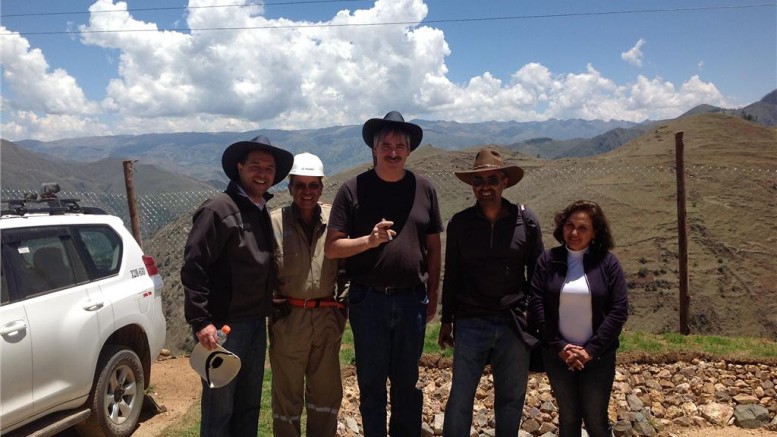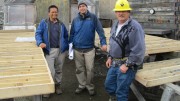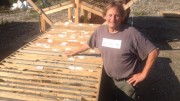CUSCO, PERU — With a large copper-gold-silver resource in its pocket at the Cotabambas project in the Peruvian Andes, Vancouver-based explorer Panoro Minerals (PML-V) is viewing 2013 as a turning point that could see the company approaching the development threshold.
Panoro’s technical team has made impressive strides since acquiring 100% of the property from an Antofagasta (ANTO-L) joint venture in 2007. The company should draw even more attention this year, as it de-risks the project and moves towards a feasibility study slated for release in 2014.
Cruising low in a helicopter over the craggy peaks and deep valleys of the Andes surrounding the project, one is struck by the ruggedness of the terrain, which makes the prolific quantity of copper exploration and development along the Eocene-Miocene porphyry belt in southern Peru all the more impressive. Cotabambas sits at the end of a 45-minute flight 50 km west of Cusco — which is famously known as the “Incan gateway” to the ruins at Machu Picchu.
The helicopter sets down on a grassy plateau before a group of tour attendees scramble to Panoro’s four-wheel drive vehicles for a quick trip along narrow dirt roads and sharp switchbacks to the company’s well-maintained encampment.
Shepherds herd flocks along the road, and members of local communities stand out along grassy hillsides in bright attire and wide-brimmed hats, worn to shelter them from the harshness of the sun at high altitudes.
“We have our community agreements in place with the Cochapata and Calla communities, so everything on-site is normal, and we don’t envision any issues in continuing to drill and complete the feasibility studies going forward,” president and CEO Luquman Shaheen explains, as the vehicles navigate steep and narrow roadways through the towns. “We have signed a co-operation agreement with the Cotabambas municipality, which isn’t necessarily required, since that is privately owned land within the municipality. We’re negotiating compensation for impacts during exploration, and that is ongoing.”
Shaheen is at home in Peru, having lived in the country and worked in the Latin American mining sector for over 17 years. His fingerprints are evident across Panoro, which also trades on the Lima Stock Exchange and maintains a strong corporate presence in Peru.
Since acquiring Cotabambas Panoro has completed 39,400 metres of drilling over 71 holes, and the company shows no signs of slowing down. Drillers are working to complete a 30,000-metre program near the site, as the tour group arrives in dust-streaked pickup trucks. The camp buzzes with activity, as workers dart in and out of offices and core shacks.
Aggressive drilling has allowed Panoro to delineate a large copper resource, which includes its Azulccaca and Ccalla deposits, totalling 404 million inferred tonnes grading 0.42% copper, 0.23 gram gold per tonne and 2.84 grams silver per tonne. The project holds 3.8 billion contained lb. copper, 3 million contained oz. gold and 36.9 million contained oz. silver at a 0.2% copper-equivalent cut-off. The company has also outlined a higher-grade inferred pit shell that hosts 200 million tonnes grading 0.54% copper, 0.3 gram gold and 3.19 gram silver.
Shaheen points out that the resource estimate accounts for 18,000 metres of the drilling, with most of the mineralization being hypogene sulphides that total 382 million tonnes grading 0.4% copper, 0.24 gram gold and 2.94 grams silver. Panoro has also outlined a much smaller oxide copper-gold resource, but the tonnage will have to increase for it to play a role in project economics. The company has established recoveries for copper, gold and silver of 87%, 62% and 60% from its hypogene sulphide material.
“We’ll have a better idea on our development options by the end of this year, and we’ll likely be looking at two alternatives,” Shaheen says. “The high-grade pit shell offers us potential for a staged build-out, and we’ll also look at a single, larger plant to start. In either case that high-grade pit is going to form an important part of the early life economics of the project. We’ll definitely explore a smaller phase-one project that could lower those capital expenditures.”
Panoro is scheduled to complete its current drill program at Cotabambas near the end of the first quarter. Shaheen says the company expects a larger resource in its next update, but stresses it is also focusing on higher-grade tonnage.
And if recent results are any indication, Panoro may well succeed in bumping its average resource grade. Infill results released in late January were highlighted by 92 metres grading 0.95% copper, 0.49 gram gold and 6.2 grams silver in hole 95, and 74 metres averaging 0.9% copper, 0.61 gram gold and 3.7 grams silver in hole 98.
“The drills won’t stop turning. Following the completion of our current program, we’ll scale down a little bit and complete the resource update. Once that is done, we’ll scale it back up again with a deeper understanding of our geological model,” Shaheen says, adding that Panoro could complete between 40,000 and 50,000 metres over the next 12 to 18 months.
Though Panoro is focusing on fleshing out its copper resources, the company has also had success during step-out and exploration drilling. Panoro made a discovery east of Ccalla in July 2012 when it cut 1,181 metres grading 0.32% copper, 0.1 gram gold and 3 grams silver in hole 68. The results reveal that there are mineralized porphyry intrusives east of the main Ccalla zone.
“At Ccalla East, our new area, we’re using the same cut-off as the resources at Ccalla, but we don’t know yet what happened near-surface, so that is the target for some shorter holes,” vice-president of exploration Luis Vela said during a technical presentation. “The drill hole you see here is representative of all the drilling we’ve done at Ccalla East, where the holes started near the bottom of the valley and intersected these new zones at depth. We haven’t drilled those from surface yet, but we’ll do vertical holes up top.”
Vela points out that Panoro has identified four porphyry centres during mapping, representing only 10% of the company’s 100 sq. km property package. He is excited about an artisanal-mining area northwest of the current Ccalla pit where the company is conducting chip sampling, and mentions two other porphyry centres called Cochapata and Huaclle that warrant drill programs.
Shaheen says that most of Panoro’s upcoming drilling will focus on an infill program at Ccalla geared at upgrading resources into the measured-and-indicated categories, with a second effort targeting Ccalla East.
“The existing money pays for the completion of the drilling, the resource model and the scoping study,” Shaheen says of Panoro’s plans. “The financing we’ve just arranged is important because it answers the question about what is next. We have our plan for this year, and that is funded. The question was always what was to come after that. Now we have the plan and financing in place to go beyond the end of this year. The fact that we completed a financing in this market is just another vindication for the project.”
On Feb. 20, Panoro announced a relative rarity in the junior space, with a $15-million bought-deal financing where the company issued 27.3 million shares at 55¢ per share. The cash will supplement $10 million Panoro reported at the beginning of January, and position it well to hit its feasibility goal in 2014.
Panoro’s rapid development has carried some equity dilution, with the company having 176 million shares outstanding at press time for a $93-million market capitalization. The company closed at 55¢ per share at press time. Shaheen is quick to point out, however, that over 50
% of Panoro’s shares are “tightly held,” and that the company boasts institutional coverage.
Given the size of Cotabambas and the growth potential in the district, it is not a stretch to see Panoro as a takeover candidate. The company’s land package lies north of the US$1.5-billion Constancia copper project, which mid-tier producer Hudbay Minerals (HBM-T, HBM-N) acquired for $305 million in 2011.
“I’m feeling good about the copper space. I think the only risk out there for junior companies right now is financing, and we’ve crossed that bridge,” Shaheen says. “In terms of development versus potential acquisition, I think we’ll make that decision going forward. Both options are open to us, and that’s why we’re looking at Cotabambas as a staged-growth asset.”
Along with Cotabambas, Panoro is restarting work at its wholly owned Antilla copper-molybdenum project 140 km southwest of Cusco. The project is smaller in scale — hosting a 154-million-tonne inferred resource grading 0.47% copper and 0.009% moly — but could offer Panoro a lower-capital production option if it goes the development route.






Be the first to comment on "Panoro on track at Cotabambas"